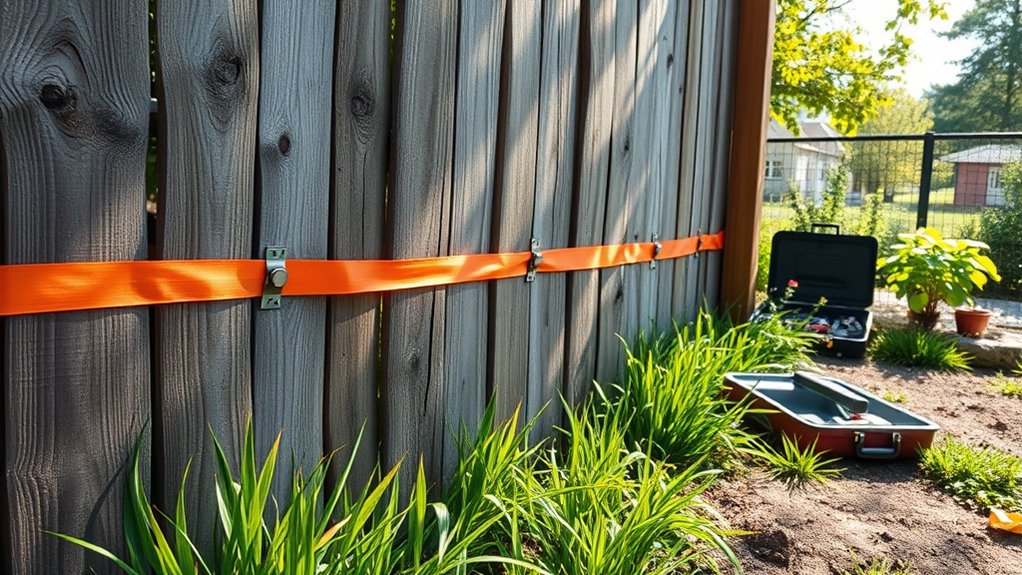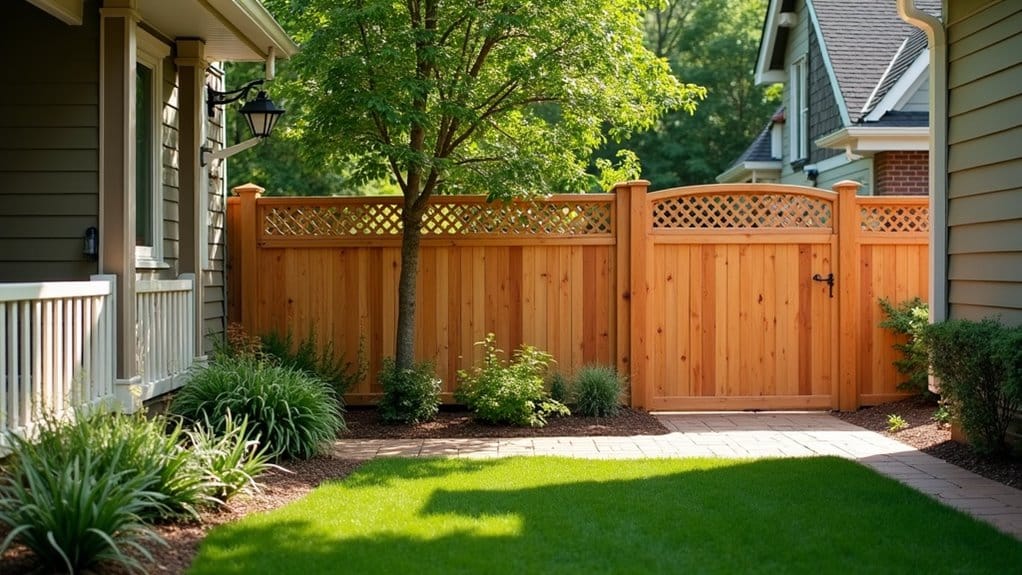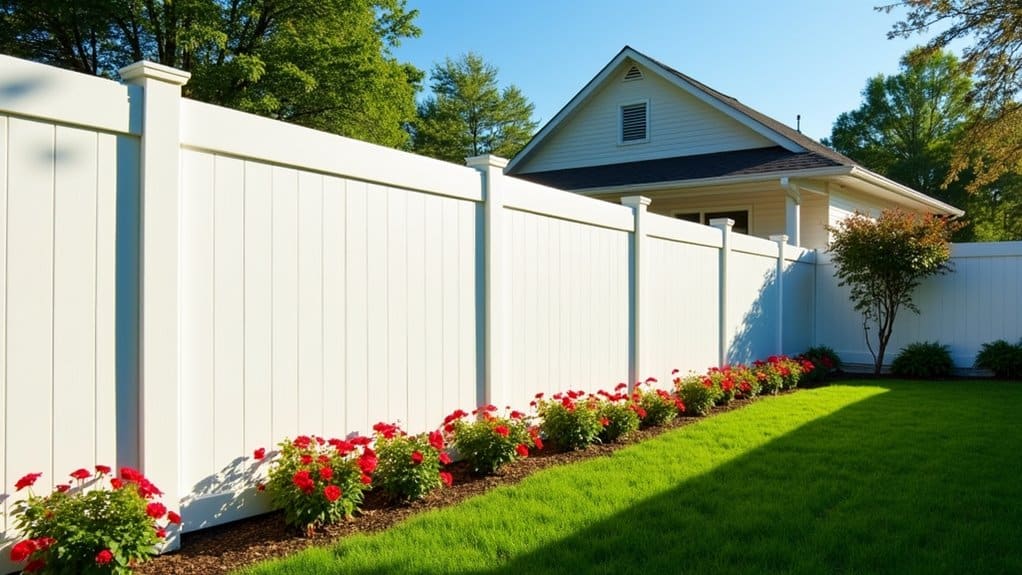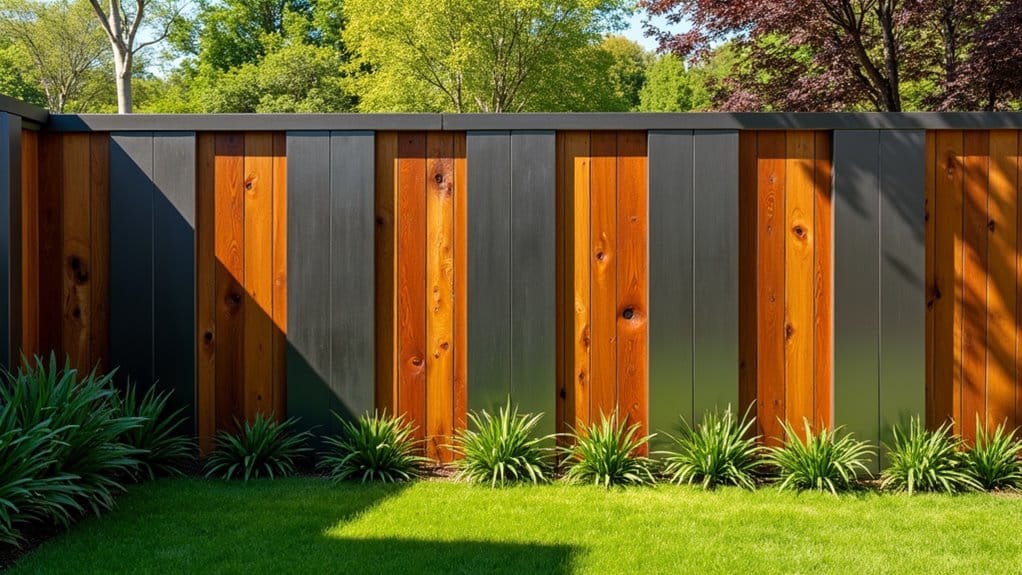If your fence is damaged, first assess the situation and set up temporary barriers for safety. Use sturdy 2×4 boards to brace leaning posts and secure them in concrete. Tighten any loose nails and replace broken boards. Proper post depth and multi-point bracing are crucial for stability. Regularly check for adjustments to maintain support until you can make permanent repairs. Need more tips?
Key Takeaways
- Assess the damage and set up temporary barriers to keep people away from the affected area.
- Use sturdy wooden braces to support any leaning or broken parts of the fence.
- If posts are broken, replace them with strong materials and ensure they’re firmly anchored in the ground.
- Tighten loose nails or screws and swap out any damaged boards to keep the fence stable.
- Regularly check and adjust your temporary supports to maintain stability until you can make permanent repairs.
Immediate Safety Measures

If you find damage to your fence, act quickly to ensure safety. First, assess how bad the damage is to determine repair urgency. Then, set up temporary barriers to keep people out of the area. It’s crucial to maintain a safe work environment to prevent further accidents during the repair process. Remove any debris that might be dangerous during repairs. It’s also a good idea to inform neighbors or local authorities about the issue. Take photos or videos of the damage for insurance purposes.
Bracing and Support Techniques

To fix fence damage effectively, it’s important to know how to temporarily replace posts and use wooden bracing techniques. Choosing the right materials can stabilize your fence and extend its lifespan until permanent repairs are made. Here are some simple strategies to support your fence and keep it standing strong. Implementing heavy-duty temporary fence bracing can significantly enhance stability against wind and other external pressures. Additionally, using wooden materials that complement your existing fence can provide an effective temporary solution while ensuring aesthetic appeal.
Temporary Post Replacement
If your fence is damaged and needs urgent help, temporary post replacement is an effective fix.
Start by checking the soil around your existing posts. Remove any broken posts and install new ones using strong materials like old antenna poles or new posts. Secure the base with ground anchors and concrete mix for extra stability. Ensure that the existing post is in reasonable condition before using a concrete spur for added support. It is important to note that proper post depth significantly influences the overall stability of your fence.
Use pry bars to adjust the new post’s position without disturbing the soil too much. This method not only supports your fence but also prepares for permanent repairs later. A well-installed temporary post can also protect against further damage in bad weather.
Wooden Bracing Techniques
Wooden bracing techniques provide a simple way to stabilize leaning or weakened fences. Start by using 2×4 boards to create temporary supports that secure the fence upright. Adjust the angle of the braces carefully for optimal support.
For fences that lean significantly, multi-point bracing is a good option. Use a power drill and galvanized screws for strong attachments, and opt for pressure-treated lumber for added durability.
Remember to check the braces regularly and make adjustments as needed. These methods will help keep your fence stable until you can make permanent repairs. Additionally, understanding the factors influencing installation time can assist in planning for more extensive repairs in the future.
Temporary Materials for Quick Repairs

To quickly fix fence damage, consider using temporary materials like epoxy wood filler or waterproof sealants to patch up problem areas.
Reinforcement brackets can support weak posts, and powder-coated metal parts are great for preventing rust in metal fences.
For fast solutions, metal fence post repair brackets and one-step temporary fence kits can save you time.
Ground anchors keep temporary posts secure, while composite materials are durable against weather.
Don’t forget UV-resistant compounds to protect your repairs from sunlight.
These temporary fixes will keep your fence stable until you can make permanent repairs.
DIY Repair Techniques for Fence Damage

When you spot damage on your fence, act quickly to prevent further issues.
Start by checking each panel for cracks or broken boards. Tighten any loose nails or screws, and look for leaning posts that may need support.
If you find broken boards, carefully remove them and replace them with new ones cut to size. To stabilize unstable posts, add support braces and ensure they’re set correctly to prevent shifting.
Use a string line to align panels at the right height before securing them.
Lastly, apply a wood preservative or sealant to protect your repairs and improve the longevity of your fence.
When to Seek Professional Assistance

If your fence shows significant damage, it’s important to determine if you need professional help.
Start by inspecting the fence closely; major breaks or structural problems usually require an expert. If there are safety hazards, like sharp edges or unstable panels, contact a professional right away.
This is especially true for underground issues or specialty materials you’re not familiar with. If you’re short on time or lack the right tools, hiring a contractor can save you effort and expense.
Quality repairs not only boost your property’s value but also ensure you meet local building codes, avoiding potential legal issues later on.
Preventative Measures for Future Fence Protection

To ensure your fence lasts longer and remains effective, it’s crucial to take preventative measures rather than waiting for damage to occur. Regular maintenance and inspections can save you both time and money in the long run.
| Preventative Measure | Benefit |
|---|---|
| Durable Materials | Lasts longer |
| Regular Inspections | Spots damage early |
| Protective Coatings | Resists rust and weather |
| Vegetation Control | Stops plant damage |
| Security Enhancements | Keeps trespassers away |
Frequently Asked Questions
How Long Can Temporary Fixes Last Before Permanent Repairs Are Needed?
Temporary repairs usually last between 1 to 12 months, depending on the materials used and the conditions they’re in. Keep an eye out for signs of wear, such as instability or visible damage. These are clear indicators that it’s time to switch to permanent repairs to ensure safety.
What Tools Are Essential for DIY Fence Repairs?
For DIY fence repairs, you’ll need a few basic tools: a hammer, screwdriver, saw, pliers, and a level. These tools will help you fasten parts, make accurate cuts, and ensure that everything is straight and sturdy, which is key for a durable fence.
Can I Use Household Items for Temporary Fence Repairs?
Yes, household items can help with temporary fence repairs. For instance, you can use bungee cords to hold up loose panels, old wooden boards to patch gaps, and duct tape for quick fixes. These solutions work well until you can make more permanent repairs.
How Do Weather Conditions Affect Temporary Fixes?
Weather significantly affects temporary fixes. For example, rain can weaken materials like wood or adhesive, while strong winds might dislodge them. Regular inspections are essential to ensure your repairs hold up. Using durable materials, such as weather-resistant tape or metal brackets, can extend the life of your fixes, even in tough conditions.
Are Temporary Repairs Covered by Homeowners Insurance?
Temporary repairs can be covered by homeowners insurance if they help prevent more damage. For example, if a pipe bursts, using tape or a bucket to catch water can be considered a necessary temporary fix. Just remember to follow your insurance claim process and keep detailed records of what you did.
Conclusion
Don’t underestimate quick fixes for your fence damage. While waiting for a professional may seem wise, temporary repairs can prevent further problems and keep your property secure. For instance, using wire or zip ties can hold up a loose panel until a proper fix is made. Taking action now not only safeguards your space but also saves you money in the long run. A little DIY effort can go a long way in maintaining your fence until you can arrange for repairs.









